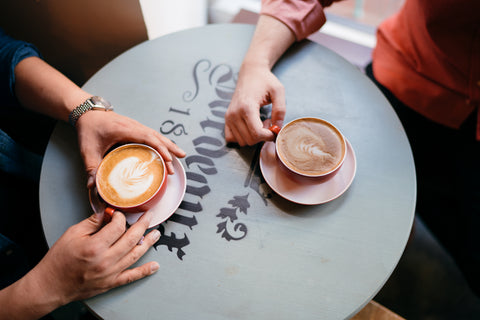
Guide: Coffee 101

Considering that coffee is something that most of us buy or brew on nearly a daily basis, you would think that we’d all be practically experts on the subject. And despite the pervasiveness of big brand coffee houses, most of us still can’t say for sure what it is that separates a great cup of joe from a mediocre one. To help us gain a better understanding and know how to best spend our hard-earned money, we sat down with Dale Donchey and Jordan Chambers – the guys behind Steady Hand Pour House in Atlanta. Breaking the subject down into the categories of beans, water and brewing methods, this is the first in a series of features on making sure that we fully experience what a good cup of coffee should taste like.
Let’s start with the basics: what exactly is coffee?
We all know that the drink itself is a caffeinated beverage, created by grinding roasted coffee beans and then applying hot water. What many forget is that coffee is a plant and a fruit. The coffee “bean” is actually the pit of a cherry from a coffee tree. The higher grades and better tasting beans are from the Arabica species of the plant. If the time-to-grind to weight ratio is right there should be notes of botanicals, fruits, herbs, tobacco, etc. The combination of 1500 flavor possibilities is what makes a well-prepared cup of coffee an experience and not just a ritual of need.
Talk more about the two types of coffee plants. What’s the difference?
The most common species we use is Coffea Arabica, which is grown in high altitudes along the Tropics of Cancer and Capricorn. This is a small part of the world, which adds to the specialness of great coffees. When cultivated properly it’s complex, balanced and diverse. Arabica takes more care and labor to maintain a high quality harvest, thus making it more expensive. Coffea Canephora or Robusta yields a lower grade of flavor with higher caffeine levels. Robusta can grow anywhere and is used by some big companies because it’s cheaper and takes less attention to cultivate. Some refer to it as the weed variety of coffee.
Since it is a plant, what is fresh and “in season” coffee?
A farm can only produce so much. The quickest coffee can be harvested and shipped to the U.S. is three months. So, to be fresh, the coffee you’re drinking should have been from the season before and most certainly no more than three seasons. The moisture in the coffee bean begins to evaporate as it sits, which kills off all the great qualities. The bean should be a rich green color before it’s roasted. Old coffee is often used for “dark roast.” Sadly, the natural flavors are all but gone, so to give the coffee any kind of uniqueness the roast substitutes as flavor.
How is coffee different in various regions?
Where as farming traditions are different region to region, a lot of the differences come from the varietal of Arabica. All coffee varieties originate from either Ethiopia or Yemen, where it still grows wild today. Places like Kenya have actually developed hybrids of the heirloom so it’s less likely to get a disease – which is mostly the result of the coffee not being a natural product of its environment. With that said, coffee from Indonesia, even if it’s the same varietal, would never be the same quality as say a Kenyan. And that is due to the farming/production of the green coffee. Indonesia coffee is often dried on dirt floors, adding to the over all earthy, vegetable flavor. Where as Kenyan coffee is dried on raised wooden tables, the air-drying of both sides of the beans brings out the brightness of the fruit. Also, the Kenyan varietal is small and dense, so it has a rich sugar content.
The post Coffee 101 (Part 1) appeared first on Bearings.
OMJ Partnerships & Recommendations
Shoes:
Crockett & Jones Ferragamo Allen Edmonds
Skincare:
Clothing/Fabric:
Barbour Todd Snyder Gladson Loro Piana Drago Abraham Moon VBC Reda Angelico Stylbiella Zegna
Accessories:
Tag Huer Hoodinkee Foundwell Jaeger Lecoultre Craighill
Read:
WM Brown GQ The Rake Garden and Gun Our State Magazine QC Exclusive Charlotte Magazine The Charlotte Ledger The New York Times
